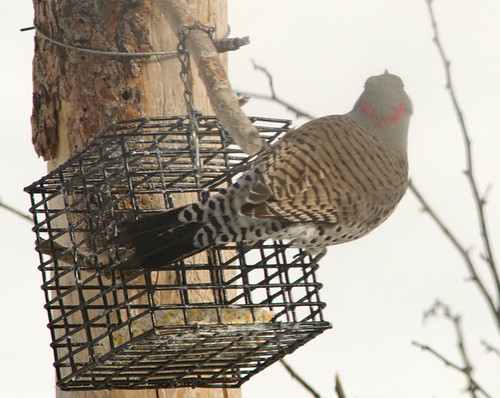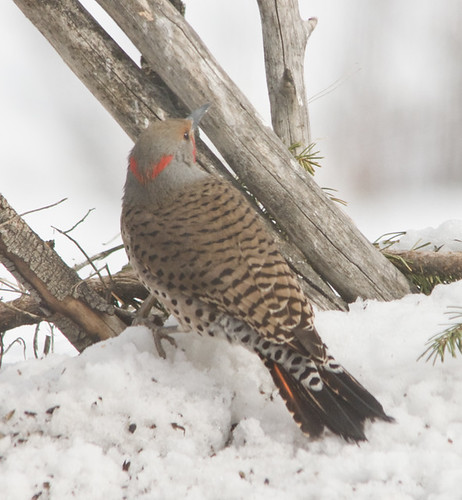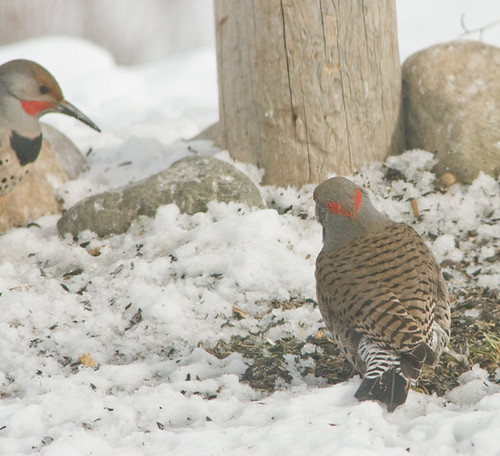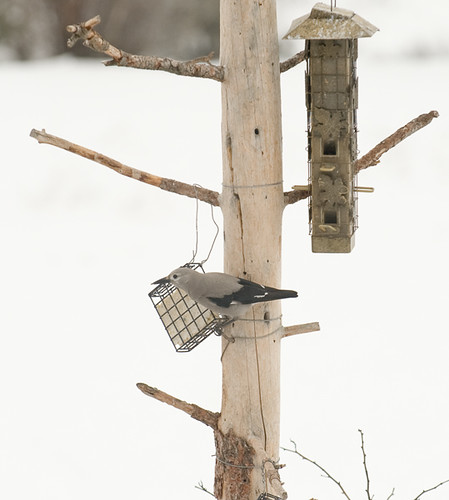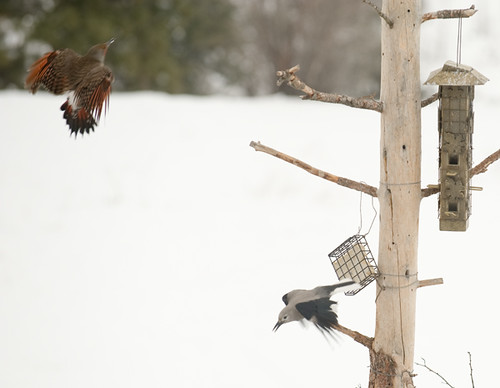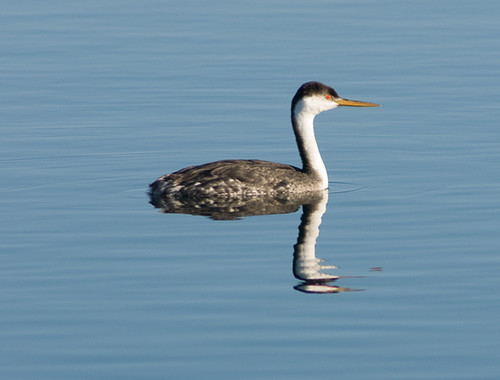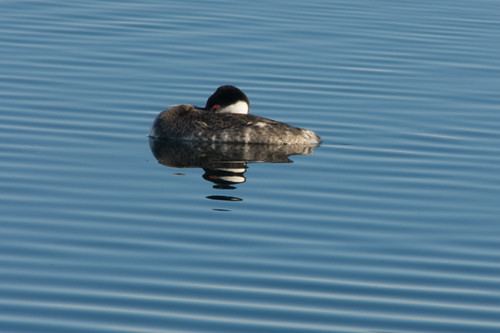Sunday, December 18
Wednesday, November 30, 2011
Leavenworth Christmas Bird Count UPDATE
Please note the change of date for the Leavenworth Christmas Bird Count.
Labels:
CBC,
Leavenworth Christmas Bird Count
Tuesday, November 29, 2011
Christmas Bird Counts in NCW
In our four-county region of North Central Washington there are at least seven Christmas Bird Counts for birders of all skill levels to enjoy. This is an entirely volunteer-driven citizen science effort. Your rewards for getting up early include seeing and learning about the wintering birds of our area, camaraderie with other birders over coffee and throughout the potentially, cold day, and usually a warm meal when darkness falls to share sightings and stories! And if you love to go owling, or just want to learn more about owls, there are usually some hardy folks who will be up in the very early morning cold and darkness looking and listening for owls! How much more fun can a person have in December and early January?
Want to know more? Here are the local counts with information to help you get involved with them.Leavenworth: December 17.
Contact Karen Haire karenhaire@nwi.net or Gretchen Rohde, gretchenrohde@me.com. CBC counters will get together at Barn Beach Reserve to warm up and share bird stories and enjoy a potluck dinner at 4:30 p.m.
Bridgeport: December 17.
Contact Meredith Spencer merdave@homenetnw.net or 686-7551. Meet at 7:00 a.m. at the Brewster McDonalds. Afterwards, enjoy a lasagna potluck at Mike and Leslie’s house at 1530 Douglas Avenue in Bridgeport.
Twisp: December 18.
Contact Leahe Swayze. leahe@methownet.com or 997-2549. Meet at the Hoot Owl Café at 123 North Glover Street in Twisp. Those who would like to eat breakfast should arrive by 6:30 a.m. (they have a good menu selection), while those who are ready to count should arrive by 7 a.m. A potluck dinner, followed by count tally, will be held at 5:30 p.m. at 521 Burgar Street. (corner of Burgar Street & Peters Road), Twisp. Leahe will provide soup — something with beans.
Grand Coulee: December 21
Contact David St. George. dstgeorge@TNC.ORG Participants will meet at Flo’s Café, 316 Spokane Way, Grand Coulee at 7 a.m. They will break up into four to six groups to cover a diverse variety of habitats from the large reservoirs, pine/fir woods, sagebrush, agricultural lands and small towns that make up the count circle. Maps and field sheets will be provided. Meet again at 4:30 p.m. at Pepper Jacks Bar & Grill, 113 Midway Avenue in Grand Coulee to compile the day’s numbers.
Chelan: December 29
Contact Steve Easley. seasley@nwi.net The plans for the Chelan CBC are identical to the past few years: Meet at 7:00 a.m. at the Apple Cup Cafe - 804 East Woodin Avenue - for breakfast and to receive assignments. At 4:45 p.m meet in the banquet room of the Apple Cup Cafe for dinner and to share results of the count. Keep in mind that whoever covers the lake in front of Campbell’s Lodge will have to ignore the swans - they’re plastic!
Wenatchee: January 1
Contact Dan Stephens. dstephens@wvc.edu or 782-4890 or 679-4706. The 50th Wenatchee CBC will be Saturday January 1st. Following the count birders will meet at the Nature Conservancy Office for a Chili feed. Please contact Dan before the count to be assigned a group and area.
Omak/Okanogan: January 2
Contact Heather Findlay heather@eaglesun.net 429-8167 or Gordon Kent at 422-6116 The count will start off at Todd and Heather’s house at 2050 James Avenue in Okanogan at 6:45 a.m. Birders may see various woodpeckers, Red Crossbills, perhaps Pygmy, White- and or Red-Breasted Nuthatches, grebes and maybe Chukars, Horned Larks and Snow Buntings. Counters are welcome to join for all or part of the day. For the diehards, when Gordon is finally dragged away from his spotting scope, when it begins to get dark, around 4:30 or so, it’s back to Todd and Heather’s for a chili feed and tallying up lists and sharing some stories from a fun day of birding!
Editor’s note: I really would LOVE to have some photos and stories from the Christmas Bird Counts to share with our Wild Phlox readers. Please keep that in mind as you enjoy your cold day of counting birds for Citizen Science!Tuesday, September 6, 2011
Birding by boat
One of my favorite ways to bird is from my kayak. Patterson Lake in Okanogan County is an excellent choice for birding by boat. It has a posted speed limit for motorized craft and that limit is generally followed. Many people powered boats can be seen there as well, including other kayaks, canoes, sculls and row boats. If you don't have a boat, you may be able to rent one from Sun Mountain's Patterson Lake cabins.
I put my boat in the water at the WDFW launch on the east side of the lake. This site requires a Discover Pass or WDFW parking permit issued with a hunting or fishing license. On weekday mornings it is never crowded. Weekends may be a different story.
This morning, after the busy Labor Day weekend, I nearly had the place to myself. The water was glassy, the sky - bluebird blue and the sun was warm. Summer weather in September. Birds know fall is coming and migration was evident. Few swallows remain of the summer swarms. White-crowned Sparrows have arrived. There was a big flock of Yellow-rumped Warblers. I did not see any Ospreys.
Small birds near the lake shore seem to be less wary of a boat than of a person on foot or bicycle. By letting my boat drift slowly, I could get good views of tiny species that generally provide only a passing glimpse.
Here is my list of 28 species seen this morning:
Hooded Merganser
Common Merganser
Great Blue Heron
Bald Eagle
Red-tailed Hawk
Spotted Sandpiper
Belted Kingfisher
Downy Woodpecker
Northern Flicker
Common Raven
Violet-green Swallow
Barn Swallow
Black-capped Chickadee
Mountain Chickadee
Red-breasted Nuthatch
White-breasted Nuthatch
Pygmy Nuthatch
American Robin
Gray Catbird
Yellow-rumped Warbler
Townsend's Warbler
Spotted Towhee
White-crowned Sparrow
Dark-eyed Junco
Black-headed Grosbeak
American Goldfinch
 |
| young Black-headed Grosbeak |
I put my boat in the water at the WDFW launch on the east side of the lake. This site requires a Discover Pass or WDFW parking permit issued with a hunting or fishing license. On weekday mornings it is never crowded. Weekends may be a different story.
This morning, after the busy Labor Day weekend, I nearly had the place to myself. The water was glassy, the sky - bluebird blue and the sun was warm. Summer weather in September. Birds know fall is coming and migration was evident. Few swallows remain of the summer swarms. White-crowned Sparrows have arrived. There was a big flock of Yellow-rumped Warblers. I did not see any Ospreys.
 |
| Canada Geese |
 |
| Mountain Chickadee |
Canada Goose
Mallard Hooded Merganser
Common Merganser
Great Blue Heron
Bald Eagle
Red-tailed Hawk
Spotted Sandpiper
Belted Kingfisher
Downy Woodpecker
Northern Flicker
Common Raven
Violet-green Swallow
Barn Swallow
Black-capped Chickadee
Mountain Chickadee
Red-breasted Nuthatch
White-breasted Nuthatch
Pygmy Nuthatch
American Robin
Gray Catbird
Yellow-rumped Warbler
Townsend's Warbler
Spotted Towhee
White-crowned Sparrow
Dark-eyed Junco
Black-headed Grosbeak
American Goldfinch
Labels:
birding,
chickadee,
geese,
grosbeak,
Kayak,
Okanogan County,
Patterson Lake,
Teri
Friday, June 24, 2011
June 20th bird walk
Only two of us turned out for the bird walk on Monday of this week. It was probably the nicest morning of the year, weather-wise. Perfect for a walk. We decided to go to the MVSTA Suspension Bridge parking area on the Community Trail and walk down valley towards the cottonwood forest in hopes of seeing some Redstarts and other specialties of that habitat. Neither one of us is good with calls of vireos and redstarts so it made hunting them down pretty difficult. The river is still running very high and there were no American Dippers in sight.
One of our choicest views was that of the Lady-slipper Orchid in a big patch next to the trail. Wild roses were also numerous and fragrant.
Here is our list of bird species.
One of our choicest views was that of the Lady-slipper Orchid in a big patch next to the trail. Wild roses were also numerous and fragrant.
Here is our list of bird species.
Turkey Vulture - seen while driving
American Kestrel - seen while driving
Mourning Dove
Black Swift - seen while driving
Rufous Hummingbird
Northern Flicker
Western Wood-Pewee
Unidentified Empidonax
Common Raven
Violet-green Swallow
Black-capped Chickadee
Red-breasted Nuthatch
Veery
Swainson's Thrush
American Robin
Gray Catbird
Cedar Waxwing
Yellow Warbler
Spotted Towhee
Chipping Sparrow
Song Sparrow
Dark-eyed Junco
Black-headed Grosbeak
Red-winged Blackbird
Cassin's Finch
Pine Siskin
Labels:
birds,
lady slipper,
Methow Valley,
orchids
Tuesday, June 14, 2011
Counting Butterflies in Chelan County
Sunday, June 26th starting at 9:00 a.m.
Looking for citizen scientists! Join biologist Phil Archibald as he leads a group for the Annual Butterfly Count from Swakane Canyon to Chumstick Mountain. Similar to the Great Backyard Bird Count, this day focuses on citizen scientists helping conservation and greater understanding of butterfly health, habitat, and migration patterns. Plus, it’s fun! Phil will help us to identify and understand butterflies and their habitat. Along the way, the group will also be birding and traveling through different types of habitat, including a recent burn. At the end of the day, the group will meet other counters and compare results.
This trip is open to all levels of birders and butterfliers and will be done by car on rough roads with short, intermittent walks. The trip is free and limited to 12 people. Please RSVP to Bridget Egan at mtnegan@gmail.com or 509-433-7306.
Labels:
butterfly,
Chelan County,
Wenatchee
Thursday, April 28, 2011
Horan Natural Area Bird Walk
Why we bird: Reminders from a Spring Bird Walk,
by Mark Oswood, NCW Audubon Society President
A few weeks ago, we had one of our traditional bird walks at Confluence Park and Horan Natural Area, in Wenatchee. We’ve had these bird walks, with a shared meal fore or aft, in spring and fall, for some years. You can never take the same bird walk twice, of course; every trip is a once-only.
We had more folks completely new to birding than in previous trips (yahooie!) so we needed more loaner binoculars and field guides than we had at hand. Question to Chapter members: should we construct a goes-anywhere, traveling kit of loaner binoculars and field guides, ready to deploy on any birding trip likely to have always-welcome neo-birders? On this trip, we had no Really Good Birders (RGB someone who can casually identify immature gulls or who knows a bird’s song from a faint “fweet” high in a tree). Having a RGB on a trip is inspirational (we all yearn to have these skills) and educational (one can learn bird lore and identification tips, just standing downwind from a RGB). Even so, there is much value in the communal learning of average birders helping each other.
We were, to our surprise, joined by a reporter (Dee Riggs) and photographer (Kathryn Stevens) from The Wenatchee World. Here’s a link to their newspaper article: http://www.wenatcheeworld.com/news/2011/apr/12/taking-flight/ . Dee asked participants why they like birding. Perhaps not surprisingly, the answers didn’t include amassing lists of birds seen but rather the ways in which birding gets us outside, slowed down, with our senses turned on and minds wide open. Annie Dillard pointed out the necessity of just showing up: “… beauty and grace are performed whether or not we will or sense them. The least we can do is try to be there.”
For us average (or especially beginner) birders, even a common bird seen closely is a gift. There were Violet-green Swallows zooming about like tiny jet fighters in a dogfight. One swallow lit on a fence wire and tolerated the intense look-rays of all of our binoculars. An Osprey, on our edge of the Columbia River, caught the downriver wind and hovered in a fish scan, nearly overhead. Our bird list for the trip had no rarities but we did get some rare good views.
Canada Goose
American Wigeon
Mallard
Lesser Scaup (could not distinguish from Greater Scaup but location/habitat make Lesser Scaup much more likely)
Bufflehead
Common Merganser
Common Loon
Double-crested Cormorant
Great Blue Heron
Osprey
American Coot
Killdeer
Ring-billed Gull
Rock Pigeon
Belted Kingfisher
Northern Flicker
American Crow
Violet-green Swallow
Black-capped Chickadee
American Robin
European Starling
Yellow-rumped Warbler
Song Sparrow
Dark-eyed Junco
Red-winged Blackbird
American Goldfinch
by Mark Oswood, NCW Audubon Society President
A few weeks ago, we had one of our traditional bird walks at Confluence Park and Horan Natural Area, in Wenatchee. We’ve had these bird walks, with a shared meal fore or aft, in spring and fall, for some years. You can never take the same bird walk twice, of course; every trip is a once-only.
We had more folks completely new to birding than in previous trips (yahooie!) so we needed more loaner binoculars and field guides than we had at hand. Question to Chapter members: should we construct a goes-anywhere, traveling kit of loaner binoculars and field guides, ready to deploy on any birding trip likely to have always-welcome neo-birders? On this trip, we had no Really Good Birders (RGB someone who can casually identify immature gulls or who knows a bird’s song from a faint “fweet” high in a tree). Having a RGB on a trip is inspirational (we all yearn to have these skills) and educational (one can learn bird lore and identification tips, just standing downwind from a RGB). Even so, there is much value in the communal learning of average birders helping each other.
We were, to our surprise, joined by a reporter (Dee Riggs) and photographer (Kathryn Stevens) from The Wenatchee World. Here’s a link to their newspaper article: http://www.wenatcheeworld.com/news/2011/apr/12/taking-flight/ . Dee asked participants why they like birding. Perhaps not surprisingly, the answers didn’t include amassing lists of birds seen but rather the ways in which birding gets us outside, slowed down, with our senses turned on and minds wide open. Annie Dillard pointed out the necessity of just showing up: “… beauty and grace are performed whether or not we will or sense them. The least we can do is try to be there.”
For us average (or especially beginner) birders, even a common bird seen closely is a gift. There were Violet-green Swallows zooming about like tiny jet fighters in a dogfight. One swallow lit on a fence wire and tolerated the intense look-rays of all of our binoculars. An Osprey, on our edge of the Columbia River, caught the downriver wind and hovered in a fish scan, nearly overhead. Our bird list for the trip had no rarities but we did get some rare good views.
Canada Goose
American Wigeon
Mallard
Lesser Scaup (could not distinguish from Greater Scaup but location/habitat make Lesser Scaup much more likely)
Bufflehead
Common Merganser
Common Loon
Double-crested Cormorant
Great Blue Heron
Osprey
American Coot
Killdeer
Ring-billed Gull
Rock Pigeon
Belted Kingfisher
Northern Flicker
American Crow
Violet-green Swallow
Black-capped Chickadee
American Robin
European Starling
Yellow-rumped Warbler
Song Sparrow
Dark-eyed Junco
Red-winged Blackbird
American Goldfinch
Labels:
birding,
Horan Natural Area,
Wenatchee
Thursday, April 21, 2011
Pearrygin Lake Bird Walk
Yesterday's Methow Valley Bird Walk went to Pearrygin Lake State Park. Seven of us quite lucked on the weather with a sunny calm morning. The water was perfectly smooth as we walked from the main campground south to the group camp area along an old road that gives views into the brush and trees below it and the lake beyond. Highlights included a calling Virginia Rail and some people saw an Osprey catch a fish while we all got to see it and another Osprey practice evasive manuevers when a Bald Eagle arrived to try to steal it. There was also a pretty good variety of waterfowl although they stayed quite a ways away and we wished we had a scope with us.
Observed species:
American Wigeon
Mallard
Northern Shoveler
Northern Pintail
Ring-necked Duck
Unknown Scaup
Common Goldeneye
Common Loon
Turkey Vulture
Osprey
Bald Eagle
Northern Harrier
Red-tailed Hawk
Virginia Rail
American Coot
Red-naped Sapsucker
Northern Flicker
Say's Phoebe
Black-billed Magpie
American Crow
Common Raven
Tree Swallow
Violet-green Swallow
Black-capped Chickadee
Mountain Chickadee
Ruby-crowned Kinglet
American Robin
European Starling
Yellow-rumped Warbler
Song Sparrow
White-crowned Sparrow
Dark-eyed Junco
Red-winged Blackbird
American Goldfinch
Total number of species seen: 34
Next scheduled Bird Walk is May 9th.
Labels:
birding,
Methow,
Pearrygin Lake
Monday, April 18, 2011
Washington's not so common Common Loon
You are cordially invited to attend Highland Wonders on the first Friday of May. Don't miss this opportunity to learn about local loons. Here is the basic information:
What: Okanogan Highlands Alliance presents a Highland Wonders educational event: "Washington's Not-So-Common Loon." Come and learn about WA loons, as Daniel and Ginger Poleschook share from their observations, research and conservation work in the Okanogan Highlands region.
When: Friday, May 6th: Dinner benefiting the Community Cultural Center at 5:00 pm; Presentation at 6:30 pm with tea, coffee and desserts
Where: Community Cultural Center, 411 S Western Ave, Tonasket, WA
Contact: Julie Ashmore at 509-433-7893 or julie@okanoganhighlands.org
More info: www.okanoganhighlands.org/education
What: Okanogan Highlands Alliance presents a Highland Wonders educational event: "Washington's Not-So-Common Loon." Come and learn about WA loons, as Daniel and Ginger Poleschook share from their observations, research and conservation work in the Okanogan Highlands region.
When: Friday, May 6th: Dinner benefiting the Community Cultural Center at 5:00 pm; Presentation at 6:30 pm with tea, coffee and desserts
Where: Community Cultural Center, 411 S Western Ave, Tonasket, WA
Contact: Julie Ashmore at 509-433-7893 or julie@okanoganhighlands.org
More info: www.okanoganhighlands.org/education
Labels:
loons,
Okanogan Highlands,
Tonasket
Sunday, April 10, 2011
Pine Grosbeak in Chelan?
This sighting/query was sent in by Virginia Palumbo. Any thoughts? Please post any comments/help below this post. Thanks!
-----------------------------------------
Has anyone seen a Pine Grosbeak in downtown Chelan or nearby? I'm nearly certain that is what I had at my feeder yesterday, but have a few questions about it, having never seen one before. It was feeding in with the Goldfinches, House Finches, Pine Siskins, and Juncos on mixed seed. (I do have many conifers in my yard, but could hardly call if a coniferous forest). It was shaped like the finches, but larger than both. It had a plain gray breast,and distinct white wing bars. It did have a short, thick curved bill, but much less ponderous than other Grosbeaks. The remarkable thing was a bright russet head and rump. It looks like the pictures of a first year male Pine Grosbeak, or female with orangish plumage. My doubt is due to the fact that it was alone, not in a flock, that it appeared closer to 8" in size rather than 9", and that Chelan is a low elevation to find a Pine Grosbeak. I'd love to hear any comments on the likelihood that this was indeed a Pine Grosbeak. I can't find anything else that comes close to this bird, and I'd love to call it my first Pine Grosbeak.
Thanks! - Virginia Palumbo
-----------------------------------------
Has anyone seen a Pine Grosbeak in downtown Chelan or nearby? I'm nearly certain that is what I had at my feeder yesterday, but have a few questions about it, having never seen one before. It was feeding in with the Goldfinches, House Finches, Pine Siskins, and Juncos on mixed seed. (I do have many conifers in my yard, but could hardly call if a coniferous forest). It was shaped like the finches, but larger than both. It had a plain gray breast,and distinct white wing bars. It did have a short, thick curved bill, but much less ponderous than other Grosbeaks. The remarkable thing was a bright russet head and rump. It looks like the pictures of a first year male Pine Grosbeak, or female with orangish plumage. My doubt is due to the fact that it was alone, not in a flock, that it appeared closer to 8" in size rather than 9", and that Chelan is a low elevation to find a Pine Grosbeak. I'd love to hear any comments on the likelihood that this was indeed a Pine Grosbeak. I can't find anything else that comes close to this bird, and I'd love to call it my first Pine Grosbeak.
Thanks! - Virginia Palumbo
Thursday, April 7, 2011
NCWAS Spring Bird Walk and Picnic: Sat. 4/9/11
Please join fellow Auduboners, families, and friends in celebration of the arrival of spring! Enjoy a morning of birding in the Horan Natural Area, followed by lunch and convivial conversation at Walla Walla Point Park, Wenatchee.
When: Saturday April 9, 2011. 9 AM - 1:30 PM (or so)
Where: Meet at picnic shelter #2 in Walla Walla Point Park (Wenatchee) at 9 AM. We will take a leisurely, 2-hour easy bird walk along the park trail through the Horan Natural Area, followed by lunch starting about 11 AM back at the picnic shelter.
What to bring: binoculars, weather-appropriate clothing, bird guides, whatever food you'd like for yourself. We'll have birding checklists, paper plates/napkins/etc., and bottled water.
More information and directions: see the NCWAS website, the April Wild Phlox, or contact Mark Oswood: email or 509-662-9087.
Hope to see you there!
When: Saturday April 9, 2011. 9 AM - 1:30 PM (or so)
Where: Meet at picnic shelter #2 in Walla Walla Point Park (Wenatchee) at 9 AM. We will take a leisurely, 2-hour easy bird walk along the park trail through the Horan Natural Area, followed by lunch starting about 11 AM back at the picnic shelter.
What to bring: binoculars, weather-appropriate clothing, bird guides, whatever food you'd like for yourself. We'll have birding checklists, paper plates/napkins/etc., and bottled water.
More information and directions: see the NCWAS website, the April Wild Phlox, or contact Mark Oswood: email or 509-662-9087.
Hope to see you there!
Thursday, March 24, 2011
Othello Sandhill Crane Festival--this weekend!
One sure sign of spring is the passage of sandhill cranes through Washington state, on their way to breeding grounds to the north. Right now, many of these magnificent birds have congregated in the fields around Othello, WA.
To see them up close, come to the 14th annual Othello Sandhill Crane Festival, March 25-27, 2011! It's a fun weekend full of talks, tours of the Columbia National Wildlife Refuge, bike birding, geology, vendors and artists, the WSU Raptor Club, and (of course!) numerous tours to see sandhill cranes and burrowing owls.
For more information, check out their website at www.othellosandhillcranefestival.org, or call 1-866-SANDHIL (1-866-726-3445). Hope to see you there!
To see them up close, come to the 14th annual Othello Sandhill Crane Festival, March 25-27, 2011! It's a fun weekend full of talks, tours of the Columbia National Wildlife Refuge, bike birding, geology, vendors and artists, the WSU Raptor Club, and (of course!) numerous tours to see sandhill cranes and burrowing owls.
For more information, check out their website at www.othellosandhillcranefestival.org, or call 1-866-SANDHIL (1-866-726-3445). Hope to see you there!
Thursday, March 3, 2011
Northern Flicker hybrid or integrade?
This flicker has been visiting our feeders recently. For how long, I don't know - I just noticed him a couple days ago. I have looked for images of flickers similar to this one but have not seen one quite like this. Maybe they are all different? It is orange shafted, like the flickers of the west usually are. However that marking on the back of his head is not like the the other hybrids I've seen in photos. They usually show a crescent shape. This is more of a v with the two lines barely coming together in the back. It's not real even and almost looks like someone used a magic marker on this bird.
I'd appreciate any comments on flicker hybrids from folks that have experience with them.
I'd appreciate any comments on flicker hybrids from folks that have experience with them.
Labels:
feeders,
hybrid,
Methow,
northern flicker,
winter
Tuesday, February 22, 2011
Sage-grouse field trip
Sage-Grouse field trip
March 5th
Leave the Easy Street Park and Ride at 5:00 AM in Wenatchee
It may be possible to meet the group somewhere along the way
Yes, 5:00 AM.
Visit a lek.
Return to Wenatchee by noon.
Led by Dr. Dan Stephens, Biology Professor, Wenatchee Valley College
Contact Dan for more info at (509) 682-6752 or dstephens@wvc.edu
Friday, February 18, 2011
The Great Backyard Bird Count has started!
This weekend, Feb. 18-21, is the 14th annual Great Backyard Bird Count. This is an event where Citizen Scientists all across the US and Canada count birds and upload their observations to a central website. You can participate for as short as 15 minutes or for all 4 days; it's free, it's fun, and it helps scientists and the birds. You can watch the counts grow in real time as the weekend progresses, which gives us all a snapshot of where birds are and how many of each species.
To find out more, and to participate, you can go to the NCWAS website or to the Great Backyard Bird Count website: http://www.birdsource.org/gbbc/.
There are also field trips taking place this weekend in North Central Washington, as part of the GBBC. For details, see the Birding page of the NCWAS website.
We look forward to seeing your observations online!
To find out more, and to participate, you can go to the NCWAS website or to the Great Backyard Bird Count website: http://www.birdsource.org/gbbc/.
There are also field trips taking place this weekend in North Central Washington, as part of the GBBC. For details, see the Birding page of the NCWAS website.
Thursday, February 3, 2011
Soup and Sharp-shins: Feb. 3, 2011
Come to the North Cascades Basecamp in Mazama for another in their winter soup-and-lecture series. Kent Woodruff, USFS Wildlife Biologist, will give a presentation Feb.3, titled "Lessons of a Little Accipiter". He will tell you about the long-term studies of raptor migration at Chelan Ridge, conducted with HawkWatch International, and will share some surprising things he's learned about the small, sharp-shinned hawk during his studies there.
Soup (seasonal vegetarian) is at 5:30 PM ($5); the talk begins at 6 PM (free). For more information or directions, please see the North Cascades Basecamp website. See you there!
Soup (seasonal vegetarian) is at 5:30 PM ($5); the talk begins at 6 PM (free). For more information or directions, please see the North Cascades Basecamp website. See you there!
Monday, January 24, 2011
Clarks Nutcracker at the feeder
The Clarks Nutcracker was first observed by William Clark (Lewis and Clark) and bears his name. I suppose it could be called Williams Nutcracker.....
Generally it eats pine seeds which it carries in a pouch unders its tongue and then caches for a rainy, or snowy, or sunny day.
This week a nutcracker decided our suet feeders looked pretty good. I wonder if it has finished its caches of seeds? Or lost them in the snow. They are supposed to have great memories for their caches.
Other members of the corvid family visit the suet feeders at our house including Stellers Jays and Black-billed Magpies.
All of the feeder birds seem to dread the arrival of a Northern Flicker and this Clarks Nutcracker was no exception. I don't know why none of the other birds care for the flickers. It's even worse when a magpie arrives.
Labels:
bird feeder,
clarks nutcracker,
Methow,
northern flicker,
Teri,
winter
Saturday, January 22, 2011
Grebe on the Columbia
Some folks think this is a Clarks Grebe, others think it is a Western Grebe. It is regularly observed just above the Chief Joseph Dam on the Columbia River by the 'burn pile'.
Subscribe to:
Posts (Atom)



